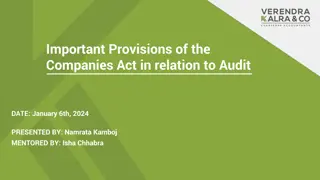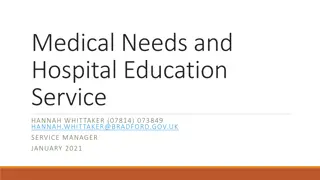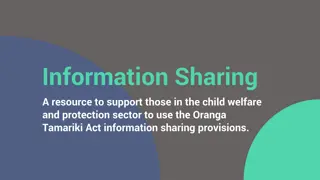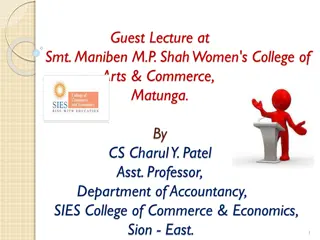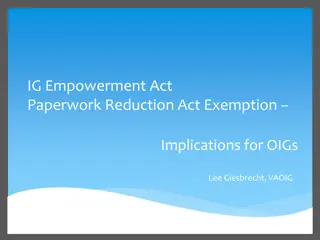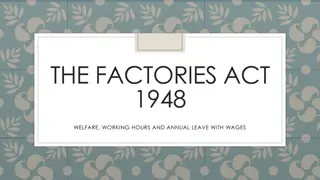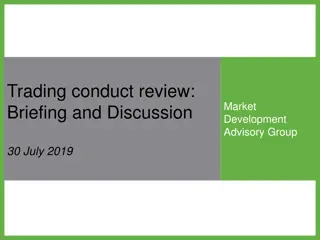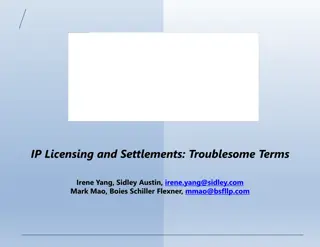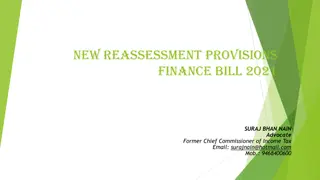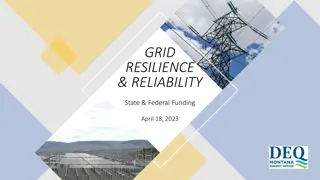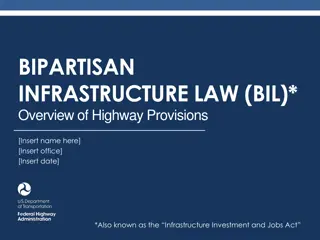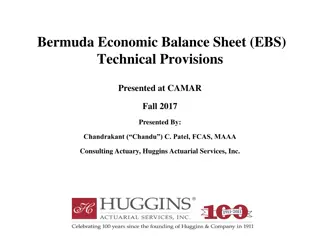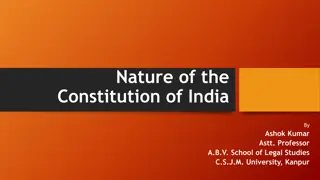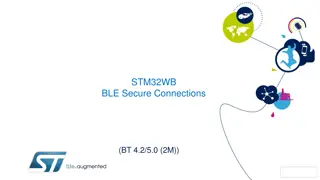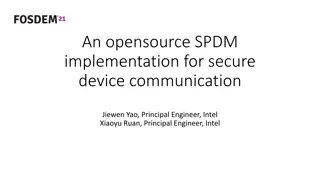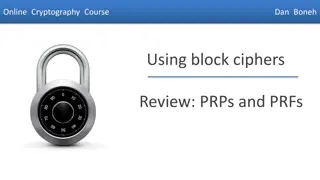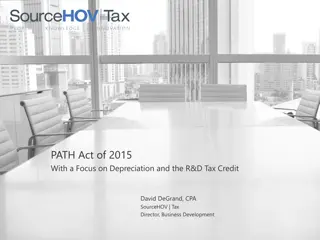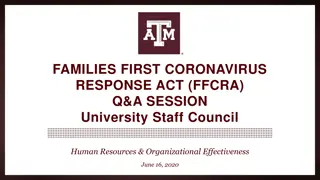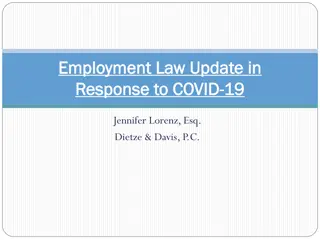Understanding Secure Act 2.0 Key Provisions
In a detailed report by Dee Spivey and Angie Zouhar, key provisions of SECURE Act 2.0 are outlined, including changes in retirement plans like RMD age increase, employee certification of hardship withdrawals, and more. Secure 1.0 and Secure 2.0 differences, effective dates, and necessary actions for plan sponsors are highlighted, while awaiting further guidance on certain provisions.
Download Presentation

Please find below an Image/Link to download the presentation.
The content on the website is provided AS IS for your information and personal use only. It may not be sold, licensed, or shared on other websites without obtaining consent from the author. Download presentation by click this link. If you encounter any issues during the download, it is possible that the publisher has removed the file from their server.
E N D
Presentation Transcript
SECURE ACT 2.0 Key Provisions & What You Need To Know Presented by: Dee Spivey, AIF, CPFA SageView Advisory Group, Retirement Plan Consultant Angie Zouhar, APR, CFS Voya, Vice President, Client Relations For Plan Sponsor Use Only SageView Advisory Group, LLC is a Registered Investment Adviser. This report is for informational purposes only and is not a solicitation to invest. Advisory services are only offered to clients or prospective clients where SageView Advisory Group, LLC and its representatives are properly licensed or exempt from licensure. Past performance is no guarantee of future returns. aInvesting involves risk and possible loss of principal capital. No advice may be rendered by SageView Advisory Group, LLC unless a client service agreement is in place.
Setting Every Community up for Retirement Enhancement SECURE 1.0 and 2.0 Secure 1.0 Passed in 2019 as part of 2020 Appropriations Bill Secure 2.0 Passed in 2022 as part of the Consolidation Appropriations Act. Secure 1.0 Included a large number of retirement specific provisions including: RMD increased to age 72 Long-term, part time employee eligibility Childbirth or adoption distributions up to $5,000 VBA is working with ERISA Counsel and Voya to determine available options for the SBA Master Trust Increased QACA safe harbor rate cap Many other provisions. Secure 2.0 Includes around 100 retirement specific plan provisions Varying effective dates Includes few required provisions Many provisions are optional Still waiting for clarification and guidance on several provisions Plan document amendments need to be completed December 31, 2025 2
Increase in RMD Age Required Change 2023 Age 73 for a person who attains age 72 after December 31, 2022, and age 73 before January 1, 2033. Age 75 for an individual who attains age 74 after December 31, 2032. [Anyone who turns 72 in 2023 is not required to take an RMD for 2023, instead they will be required to start taking RMDs for calendar year 2024, the year they turn 73] Considerations: No action required from Plan Sponsor Voya processes all Required Minimum Distributions and the recordkeeping system is updated to reflect the change
Employee Certification of Hardship Withdrawals Optional in 2023 Employer may rely on employee certification that deemed hardship distribution conditions are met There may be possible exceptions to this reliance, such as where plan fiduciaries have actual knowledge that is inconsistent with the certification Considerations: Voya is currently reviewing and approving all hardship distributions. It is important to note that while Voya is collecting documentation to review and approve the distribution, the plan sponsor still assumes liability that the hardship meets the current IRS definition. Plan sponsor liability COULD be reduced allowing self certification Voya will develop online participant experience for plans electing self certification
Treatment of Employer Matching or Nonelective Contributions as Roth Optional in 2023 Allows defined contribution plans to provide participants with the option of receiving employer contributions on a Roth basis Matching and nonelective contributions designated as Roth contributions are not excludable from the employee s income and must be 100% vested when made Considerations: Still awaiting guidance from DOL Could consider offering the in-plan Roth conversion feature for participants to accomplish the same outcome 32.5% of SBA plans offer the in-plan Roth conversion
Simplification of Notice Requirements to unenrolled participants Optional in 2023 Employers no longer required to provide certain notices to eligible employees that have elected not to participate in the plan. Employees must have received SPD and other eligiblity/enrollment notices Annual eligiblity reminder notices and employee requested documents still required Considerations: Voya currently prepares and distributes all participants notices for plan sponsors Voya is in the process of updating their system to accommodate the provision
Catch Up Contributions in Roth Required in 2024 All catch up contributions are subject to Roth tax treatment Exemption for employees making less than $145,000 (based on 2023 compensation) Considerations: Add Roth contributions to plan if not currently available Voya is in the process of updating the recordkeeping system to assist plan administrators in complying with this provision Consider a review of the current employee census to identify employees over 50 years old (eligible for catch up) AND with compensation over $145,000 and notify the affected participants of the upcoming change Ask your payroll vendor if there will be any programming updates to help monitor this requirement
Updating dollar limit for mandatory distributions Optional 2024 The limit for mandatory cash outs increased from $5,000 to $7,000 (without any indexation in future years). Considerations: This is a good opportunity to review current employee census data to ensure participant termination dates are correct in the Voya recordkeeping system. This is a good opportunity to review the current automated force out program. Effective June 2024 Voya will use the maximum limit under law which increases to $7,000. Sponsors who wish for Voya to continue processing small balance mandatory distributions for their plan will need to comply with the change to $7,000
Improving Coverage for part time workers Required in 2025 Under SECURE Act, plans must permit an employee to contribute to the plan if the employee has worked 500 hours per year for three consecutive years. SECURE 2.0 reduces from three to two years of 500 hours or more Considerations: The current law, SECURE 1.0, would override any employee exclusions. Existing employee exclusions may include: Hourly employees, Seasonal, Intern, Straight Time Hourly In order to comply with the SECURE 1.0 provision , plan administrators should review hours worked for employees in question for years 2021, 2022, 2023. In order to comply with the SECURE 2.0 provision, plan administrators should review hours worked for employees in question for years 2023 and 2024.
Additional Provisions under Secure 2.0 Provision Effective Date Required / Optional For distributions made after enactment Distribution provision is OPTIONAL, repayment period is required Qualified Birth and Adoption Distributions Allows penalty free distribution for child birth or adoption Repayment allowed within 3 years Withdrawals for Certain Emergency Expenses Penalty free withdrawal up to $1,000 per year for emergencies Must be for unforeseeable or immediate finanical needs relating to personal or family emergency Option to repay within 3 years May rely on employee self-certification No further distributions allowed during 3 years unless distribution is repaid, or deferrals made equal to amount of distribution 01/01/2024 Optional 01/01/2024 Optional Matching Contributions on Student Loan Payments Allows employers to make matching contributions to qualified student loan repayments Employer may self certify loan repayment Employers are permitted to apply the ADP test separately to employees who receive matching contributions on account of student loan payments 01/01/2024 Optional Penalty Free Withdrawal for Domestic Abuse Distribution allowed of lesser of $10k or 50% of account balance Includes abuse of child or household member Victim can self certify Can be repaid within 3 years
Additional Provisions under Secure 2.0 Provision Effective Date Required / Optional 01/01/2024 Optional Pension Linked Emergency Savings Account Up to $2500 emergency savings account in the plan Employers may auto enroll up to 3% Contributions are in Roth and count toward annual deferral limit Contributions are eligible for match, if applicable Must allow at least 1 withdrawal per month, at least 4 penalty free HCE s may not participate 01/01/2024 REQUIRED Roth Plan Distribution Rules Eliminates the requirement for participants in qualified plans to receive RMDs for Roth accounts 01/01/2025 REQUIRED Higher Catch-Up Limit for age 60 63 The greater of 10,000 or 150% of the regular limit Increased amounts will be indexed after Dec. 31, 2015


